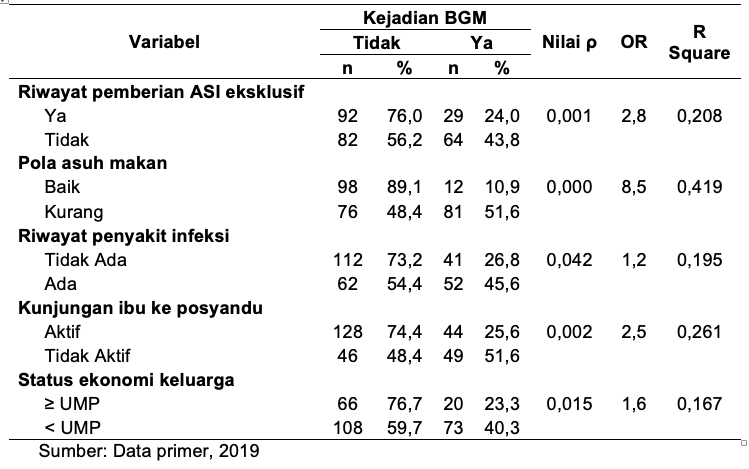Determinan Kejadian Berat Badan di Bawah Garis Merah (BGM) pada Balita
Determinants of Under-Red Line Weight Occurrence in Toddlers
Keywords:
Underweight Red Line, Toddlers, Exclusive Breastfeeding History, Feeding PatternsAbstract
The prevalence of under-five children under-red line in the working area of Karang Intan I Public Health Center is very high and continues to increase. In 2016 it was 10.3%, and in 2017 it was 12.2%. This study aimed to determine the factors associated with the occurrence of body weight below the red line in toddlers in the working area of Karang Intan 1. This study used analytic survey methods with cross-sectional approach. This study population was all toddlers, amounting to 801 people and a sample of 267 people with the purposive sampling method. The instrument used a questionnaire. The test used was the Chi-Square statistical test. The results showed a relationship between the history of exclusive breastfeeding (ρ=0.001), feeding patterns (ρ=0,000), history of infectious diseases (ρ=0.042), maternal visits to Integrated healthcare center (Posyandu) (ρ=0.002), family economic status (ρ =0,0151) with the occurrence of body weight below the red line (BGM) in infants. Conclusion: there is a relationship between exclusive breastfeeding, eating care, history of infectious diseases, maternal visits to the Posyandu, family economic status towards the occurrence of body weight below the red line in toddlers. Parenting is a significant determinant of BGM events. These determinants can be used for screening the development and growth of infants.
Downloads
References
Kementerian Kesehatan R.I. Profil Kesehatan Indonesia Tahun 2016. Jakarta: Kementerian Kesehatan R.I.; 2017.
Kementerian Kesehatan R.I. Profil Kesehatan Indonesia Tahun 2017. Jakarta: Kementerian Kesehatan R.I.; 2018.
Proverawati A, Asfuah S. Gizi untuk Kebidanan. Yogyakarta: Nuha Medika; 2009.
Sandjaja A. Kamus Gizi : Pelengkap Kesehatan Keluarga. Jakarta: Penerbit Buku Kompas; 2009.
Irianto K. Gizi Seimbang dalam Kesehatan Reproduksi = Balanced Nutrition in Reproductive Health. Bandung: Alfabeta; 2014.
Marmi, Rahardjo K. Asuhan Neonatus Bayi, Balita, dan Anak Prasekolah. Jogjakarta: Pustaka Pelajar; 2012.
Marimbi H. Tumbuh Kembang Status Gizi dan Imunisasi Dasar Pada Balita. Jogjakarta: Nuha Medika; 2010.
Dinas Kesehatan Kabupaten Banjar. Profil Kesehatan Kabupaten Banjar 2017. Martapura: Dinas Kesehatan Kabupaten Banjar; 2018.
Astutik RY. Payudara dan Laktasi. Jakarta: Salemba Medika; 2014.
Lastanto, Indri H, Cindy A. Analisis Faktor Yang Mempengaruhi Kejadian Balita Gizi Kurang di Wilayah Kerja Puskesmas Cebongan. J Stikes Kusuma Husada. 2014;1(1):1–14.
Harahap SM. Pengaruh Perilaku Ibu Terhadap Kejadian Bawah Garis Merah (BGM) Pada Anak Balita Di Wilayah Kerja Puskesmas Sayur Matinggi Kabupaten Tapanuli Selatan [Internet]. Universitas Sumatera Utara; 2014. Available from: http://repository.usu.ac.id/handle/123456789/45095
Destriatania S, Febry F. Determinan Kejadian Anak Balita di Bawah Garis Merah di Puskesmas Awal Terusan. J Ilmu Kesehat Masy [Internet]. 2016;7(1):48–63. Available from: http://www.jikm.unsri.ac.id/index.php/jikm
Sriyani. Faktor yang Berhubungan dengan Kejadian Balita Bawah Garis Merah (BGM) di Wilayah Kerja Puskesmas Tatah Makmur Kabupaten Banjar. Poltekkes Kemenkes Banjarmasin; 2018.
Jevita jhodit JJ, Wibowo H. Balita Bawah Garis Merah di Wilayah Kerja Puskesmas Cukir Diwek Jombang. Ilmu kebidanan [Internet]. 2015;1(2):1–7. Available from: http://journal.stikespemkabjombang.ac.id/index.php/jikeb/article/download/73/71/
Hilmiyah K, Afriyani LD. Hubungan Kepatuhan Dalam Kunjungan Posyandu Terhadap Status Gizi Balita Di Desa Mlilir Kecamatan Bandungan Kabupaten Semarang. Indones J Midwifery. 2018;1(2):85–8.
Safitri YA, Darmaningtyas IP. Pola Makan Batita “Z” Dengan Status Gizi Bgm (Bawah Garis Merah) Di Puskesmas Ketawang Kabupaten Malang. J Hesti Wira Sakti. 2016;4(1):94–100.
Wahyudi BF, Indarwati R, Wahyudi BF. Analisis faktor yang berkaitan dengan kasus gizi buruk pada balita. J Pediomaternal. 2015;3(1):83–91.
Linda. Hubungan Pemberian Asi Eksklusif dan Bayi Berat Lahir Rendah (BBLR) dengan Kejadian Pneumonia pada Balita di Wilayah Puskesmas Kamonji. J Bidan Cerdas. 2018;1(1):27–33.
Nurhalimah. Faktor Yang Mempengaruhi Pemberian ASI Eksklusif Di Wilayah Kerja Puskesmas Aranio Kabupaten Banjar. Poltekkes Kemenkes Banjarmasin; 2018.
Sari G, Lubis G, Edison E. Hubungan Pola Makan dengan Status Gizi Anak Usia 3-5 tahun di Wilayah Kerja Puskesmas Nanggalo Padang 2014. J Kesehat Andalas [Internet]. 2016 Aug 11;5(2). Available from: http://jurnal.fk.unand.ac.id/index.php/jka/article/view/528
Putri RF, Sulastri D, Lestari Y. Faktor-Faktor yang Berhubungan dengan Status Gizi Anak Balita di Wilayah Kerja Puskesmas Nanggalo Padang. J Kesehat Andalas [Internet]. 2015 Jan 1;4(1). Available from: http://jurnal.fk.unand.ac.id/index.php/jka/article/view/231

Published
How to Cite
Issue
Section
Copyright (c) 2020 Authors

This work is licensed under a Creative Commons Attribution-ShareAlike 4.0 International License.
Authors who publish with Jurnal Bidan Cerdas agree to the following terms:
- Authors retain copyright and grant the journal right of first publication with the work simultaneously licensed under a Creative Commons Attribution License (CC BY-SA 4.0) that allows others to share the work with an acknowledgment of the work's authorship and initial publication in this journal.
- Authors are able to enter into separate, additional contractual arrangements for the non-exclusive distribution of the journal's published version of the work (e.g., post it to an institutional repository or publish it in a book), with an acknowledgment of its initial publication in this journal.
- Authors are permitted and encouraged to post their work online (e.g., in institutional repositories or on their website) prior to and during the submission process, as it can lead to productive exchanges, as well as earlier and greater citation of published work.

This work is licensed under a Creative Commons Attribution-Share Alike 4.0 International License
You are free to:
- Share, copy and redistribute the material in any medium or format
- Adapt, remix, transform, and build upon the material for any purpose, even commercially.
- The licensor cannot revoke these freedoms as long as you follow the license terms.




